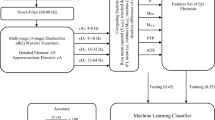Summary
Automated artifact classification of quantified EEG (QEEG) epochs from 9 males using linear discriminant analysis showed greater than 85% agreement with judges' opinions. These results were replicated (n=600 epochs for each sample). Testing the entire sample (n=5800) illustrated reliable eye artifact (94%) but reduced muscle artifact classification (70%) accuracy. Agreement was lowest in the case of more subtle forms of muscle artifact (i.e., low amplitude muscle), however, less than 4% of these were wrongly classified as non-artifact. Improved data collection techniques retaining high frequency energies are anticipated to improve muscle artifact recognition. Results indicate that low levels of artifact contamination would result when only those epochs classified as non-artifact were accepted for inclusion in further analysis.
Similar content being viewed by others
References
Barlow, J.S. Artifact processing (rejection and minimization) in EEG data processing. In F.H. Lopes da Silva, W. Storm van Leeuwen and A. Remond (Eds.), Handbook of Electroencephalography and Clinical Neurophysiology (Revised Series, Volume 2, pp. 15–62). New York: Elsevier, 1986: 15–62.
Fortgens, C. and De Bruin, M.P. Removal of eye movement and ECG artifacts from the non-cephalic reference EEG. Electroenceph. Clin. Neurophysiol., 1983, 56: 90–96.
Gevins, A.S. Pattern recognition of human brain electrical potentials. IEEE Trans. Pattern Anal. Machine Intel., 1980, PAMI-2: 383–404.
Hinrichs, H. EEG data acquisition. Neuropsychobiology, 1987, 17: 77–84.
Kahn, E.M., Weiner, R.D., Brenner, R.P. and Coppola, R. Topographic maps of brain electrical activity—pitfalls and precautions. Biological Psychiatry, 1988, 23: 628–636.
Matousek, M. and Volavka, J. The subjective factor in the results of EEG frequency analysis. Activa. Nerv. Sup., 1967, 9: 75–79.
Takarada, T., Alvarado, L.G., Nishida, F. and Nishino, M. Frequency analysis of the EMG power spectrum of the anterior temporal and masseter muscles in children and adults. Shoni-Shikagaku-Zasshi, 1989, 27(4): 884–894.
Van den Berg-Lensse, M.M.C., Brunia, C.H.M. and Blom, J.A. Correction of ocular artifacts in EEGs using an autoregressive model to describe the EEG: A pilot study. Electroenceph. Clin. Neurophysiol., 1989, 73: 72–83.
Woestenburg, J.C., Verbaten, M.N. and Slangen, J.L. The removal of eye-movement artifact for the EEG by regression analysis in the frequency domain. Biological Psychology, 1983, 16: 127–147.
Author information
Authors and Affiliations
Rights and permissions
About this article
Cite this article
MacCrimmon, D.J., Durocher, G.J., Chan, R.W.Y. et al. Computerized pattern recognition of EEG artifact. Brain Topogr 6, 21–25 (1993). https://doi.org/10.1007/BF01234123
Accepted:
Issue Date:
DOI: https://doi.org/10.1007/BF01234123




